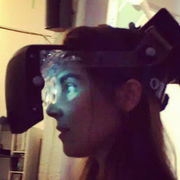New research out of the Department of Psychology finds that people can read others’ attentional states by observing their actions.
The study, Humans are sensitive to attention control when predicting others’ actions, shows that many of us have a keen ability to read the attentional states of others through their actions. But this ability is also unconscious to us. The study finds that reading someone else’s attentional states is associated with empathy and social intelligence; those with greater empathy are better at this unconscious process.
In this Q&A, Ana Pesquita, the study’s lead author and a graduate student, discusses her research on reading others’ attentional states through action observation.
What does your research involve?
Imagine you are sitting in a cafe. A girl enters. You both recognize each other as the unflattering versions of your profile photographs. Your date has started. As the first minutes pass you wonder: Will she leave or stay? Knowing the focus of her attention will considerably narrow down your predictions about her future behaviour. If her eyes are fixed on you, there is some hope. If her eyes wander, not so much. Alas, she glances languidly at her phone. You decide to beat her to the punch, and politely announce how good it was to have met her. As illustrated by this example, we track the focus of someone else’s attention to predict their future behaviour and adapt accordingly. It is well established that humans are remarkably sensitive to ‘where’ someone is attending. However, as the example suggests, there is also important social information in knowing ‘how’ attention is controlled. Whether your date intentionally decided to direct her attention away from you (endogenous control) or merely turned to the phone because it unexpectedly blinked (exogenous control) tells you different things about her mental state, and possibly about the success of your date. This observation led my colleagues and me to the question of whether humans are sensitive to attention control in the observed actions of others.
What did the results show?


Ana Pesquita
To address the question above, we created a laboratory scenario in which actors had to reach towards one of two possible targets. We video-taped these actors in two different situations: The actors either chose their end-target (endogenous control) or were externally directed to the end-target (exogenous control). We then presented these videos to naïve observers and asked them to predict as fast as possible the end-target of actor’s reaches. The results showed that observers were faster at correctly predicting endogenously controlled actions compared to exogenously controlled ones. Thus offering a positive answer to the question ‘Are observers sensitive to someone else’s attention control?’ However, we also found that this sensitivity was processed at the unconscious level. In particular, when asked to report whether an action was endogenously or exogenously controlled observers’ responses were at chance-level, indicating that they don’t have a conscious elaboration of the actor’s internal attentional state. Interestingly, observers’ autistic traits were negatively correlated with their sensitivity to the actors’ attentional states. Overall, our results indicate that humans have an implicit sensitivity to each other’s attentional states that is linked to social aptitude.
Did anything surprise you?
The clear relationship between self-reported autistic traits and sensitivity to someone else’s attentional states surprised me. Although this observation is aligned with the well-accepted notion that the social perception of attention is relevant to the Theory of Mind (i.e. the human ability to infer someone else’s inner intentions), our findings are novel because they reflect what are likely to be the early low-level inputs to Theory of Mind processes.
Are you planning any follow-up research?
Yes! We are currently developing a new set of studies to dissociate between sensitivity to attentional states and sensitivity to action preparation. In these new studies, we are also capturing in greater detail actors’ bodily movement kinematics. These new studies will help us to better understand the social perception of attention.
The study was published in the August 2016 edition of the Proceedings of the National Academy of Sciences. Its co-authors include Dr. James Enns, professor, Department of Psychology, University of British Columbia and Dr. Craig Chapman, assistant professor, Faculty of Physical Education and Recreation, University of Alberta.



